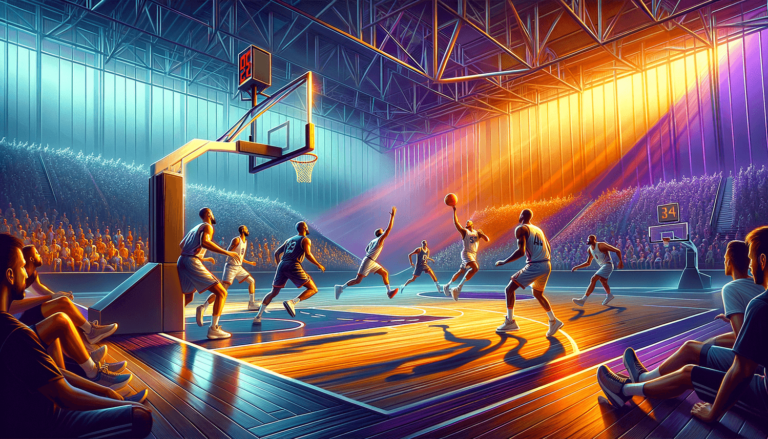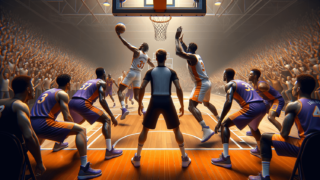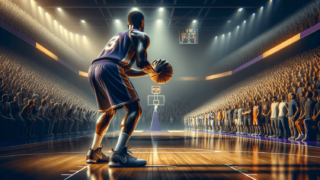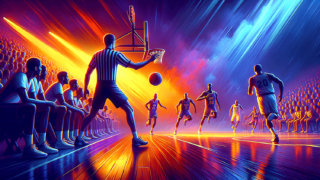
Regardless of whether you are new to the world of basketball, or an experienced player, a thorough understanding of the game’s various nuances and rules is a must. One rule that often stirs curiosity and plenty of heated discussions is the infamous “Technical Foul”. In this fun, yet professional exploration, we will dive into the realm of technical fouls, break down different types, and demystify the not-so-obvious aspects that make this rule a pivotal part of basketball dynamics. So, fasten your (figurative) sneakers, as we prepare to navigate the intricate world of technical fouls!
What Is a Technical Foul in Basketball?
A technical foul in basketball is a violation of the game’s rules for unsportsmanlike, non-basketball-related conduct. It can be committed by players, coaches, or team personnel, and it typically results in a free throw for the opposing team, as well as possession of the ball. Examples of technical fouls include disrespectful behavior towards referees, excessively arguing calls, using profane language, or even actions that delay the game unnecessarily.
Unraveling the Intricacies of Technical Fouls
Before understanding the different types of technical fouls and their implications, it is important to distinguish a technical foul from a personal foul. Personal fouls occur when there is illegal physical contact between players during the course of the game, whereas technical fouls involve violations of the game’s conduct, spirit, or regulations without physical contact. Now that we have our bearings, let’s shed some light on the complex world of technical fouls in basketball.
Classifications of Technical Fouls
The National Basketball Association (NBA), International Basketball Federation (FIBA), and NCAA each have their own set of rules and regulations, but they all have one common goal: maintaining the integrity, fairness, and competitiveness of basketball. While differences may exist between these organizations’ understanding of technical fouls, we will explore them as a whole.
Player Technical Fouls
Technical fouls in basketball are often committed by the players themselves. These violations may result from any action that displays unsportsmanlike conduct, disrespects the officials, disrupts the game flow, or any other action deemed inappropriate. Here are some common examples of player technical fouls:
- Arguing with the referee or excessively questioning their decision
- Using profane or offensive language directed at the referee, opponent, or teammate
- Making inappropriate gestures or taunting opponents
- Excessively hanging on the rim after a dunk
- Purposefully delaying the game, like taking too long to shoot a free throw
- Interfering with an inbound passer or stepping over the boundary line while defending the inbound play
Coach and Team Personnel Technical Fouls
Coaches and team personnel can also be held responsible for technical fouls. They are expected to maintain a professional demeanor while supporting and guiding their teams. The following actions might result in technical fouls for coaches and team personnel:
- Excessively arguing with the referee or publicly disputing their decisions
- Using offensive language or making inappropriate gestures towards the referee, opposing coaches or players, or even their own team members
- Leaving the designated coaching area to enter the court during the game
- Requesting a timeout when the team has none remaining
Team Technical Fouls
Besides individuals, the team as a whole can get hit with a technical foul. Some examples of team technical fouls include:
- Having six players on the court during play
- Not being ready to start the game, resume play after a timeout, or start a quarter or overtime period
- Delayed game tactics like excessive towel use on the court or unnecessary delays during warm-up
The Consequences of Technical Fouls
Technical fouls carry penalties that can have a significant impact on a game’s outcome. The following are some consequences that result from technical fouls:
Free Throws and Possession
When a team or individual commits a technical foul, the opposing team is awarded one or two free throws, depending on the specific league regulations. In the NBA, for example, one free throw is awarded to the opposing team. Following the free throw, possession is also granted to the non-violating team, which means the team that committed the technical foul is punished twice: free points and loss of possession.
Fines and Suspensions
In addition to in-game penalties, players, coaches, and team personnel may face further disciplinary action for their behavior that resulted in a technical foul. In professional basketball leagues like the NBA, fines are often imposed on players, coaches, or franchises for incidents deemed severe or repeated.
Technical Foul Count
Technical fouls accumulate through the course of the season for players and coaches. In leagues like the NBA, both regular season and playoff technical foul counts are maintained separately. Accumulation of a certain number of technical fouls within a single season can result in automatic suspensions and/or fines, as well as escalations in the severity of the punishment for each successive technical foul.
Flagrant Fouls: A Noteworthy Mention
Although distinct from technical fouls, flagrant fouls are crucial to discuss due to their connection to unsportsmanlike conduct. A flagrant foul occurs when a player commits unnecessary and/or excessive contact against an opponent. Unlike a technical foul, a flagrant foul involves physical contact that is deemed intentional and dangerous.
Flagrant fouls are further classified into two categories:
- Flagrant 1: Unnecessary contact without intent to harm or cause injury
- Flagrant 2: Unnecessary and excessive contact with intent to harm or cause injury
Flagrant fouls result in penalties similar to those of technical fouls, with free throws and possession awarded to the opposing team. However, flagrant fouls can also lead to immediate ejections, suspensions, or even fines, depending on the severity.
Avoiding Technical Fouls: Tips for Players and Coaches
Technical fouls can alter the momentum of a game and hurt a team’s chances of winning. It is crucial for players and coaches to exercise restraint and embody sportsmanship to avoid committing technical fouls. Here are some tips:
Maintaining Emotional Composure
Basketball is a high-energy and fast-paced sport where emotions can quickly escalate. Players and coaches should focus on managing their emotions and maintaining composure, even during tense game situations.
Effective Communication with Referees
Voicing concerns or seeking clarification from referees is natural during a game. However, it is essential to communicate respectfully and professionally. Remain calm, approach the referee during break periods, and avoid excessive arguing or aggressive behavior.
Embracing Sportsmanship
Winning a game is important, but demonstrating good sportsmanship is even more significant. Players and coaches should respect opponents, referees, and the people around them. Display courtesy, fairness, and grace in victory or defeat, and always put the spirit of the game first.
Technical Fouls: A Staple of Basketball’s Unpredictability
Technical fouls are one of the many aspects that make basketball such an engaging and unpredictable sport. Understanding their implications is vital for every enthusiast and participant. By steering clear of unsportsmanlike behavior, players and coaches not only avoid penalties but also contribute to the rich and exciting tapestry of the game we all love.
Understanding the Referee’s Signals
Referees in basketball are required to follow specific procedures while calling fouls, including using specific hand signals or gestures to indicate the type of foul committed. To gain a better understanding of the game, it’s essential to recognize the signals associated with technical fouls, as well as other fouls in the game. Here’s an overview of some of the most critical referee signals:
Technical Foul Referee Signal
When a technical foul is committed, the referee will indicate this by forming a T-shape using both hands. The right hand, with the fist closed, is placed below the left hand, which is held horizontally with open palm.
Flagrant Foul Referee Signal
In case of a flagrant foul, the referee will indicate the type of flagrant foul (Flagrant 1 or 2) by placing a clenched fist on top of their head and raising their index finger for Flagrant 1, or two fingers for Flagrant 2.
Personal Foul Referee Signals
Referees will also signal various types of personal fouls, such as:
- Holding Foul: Referee will signal by making a holding gesture using both arms
- Pushing Foul: Referee will signal by extending one arm and making a pushing motion
- Charging Foul: Referee will signal by placing their fist on their hip, elbow bent outward
- Blocking Foul: Referee will signal by crossing their arms with closed fists, palms facing down
By familiarizing themselves with these signals, players, and spectators can quickly understand the referee’s decisions during a game.
Notable Technical Foul Stories in Basketball History
Technical fouls have often played pivotal roles in basketball games, leading to dramatic outcomes and creating historical moments in the sport. Here are a few noteworthy stories involving technical fouls that left an indelible mark on basketball history:
The Rasheed Wallace Technical Foul Record
Rasheed Wallace, a former NBA player, holds the record for the highest number of technical fouls in a single season. During the 2000-2001 NBA season, Wallace received a staggering 41 technical fouls, a record that still stands today. His fiery temperament and confrontational attitude were well-known among fans and players alike.
The Dennis Rodman and Referee Incident
Dennis Rodman, an NBA legend, was no stranger to technical fouls throughout his career. However, one particular incident stands out. In a game against the Minnesota Timberwolves in 1997, Rodman was frustrated with a series of calls made by the referee, resulting in a technical foul. In an act of retaliation, Rodman head-butted the referee, earning another technical foul and ejection from the game. This incident led to a six-game suspension and a hefty fine.
Draymond Green’s Suspended Playoff Game
During the 2016 NBA Finals, Draymond Green of the Golden State Warriors was involved in a controversial incident with LeBron James of the Cleveland Cavaliers, which led to Green being assessed a Flagrant 1 foul. With his flagrant foul points accumulation during the playoffs, Green was forced to serve a one-game suspension during Game 5 of the NBA Finals. This pivotal suspension is considered a crucial turning point in the series, which the Cavaliers ultimately won in seven games, securing their first-ever NBA Championship.
The world of technical fouls is undoubtedly a fascinating aspect of basketball that adds to the game’s excitement, intensity, and drama on the court. By understanding the rules and consequences of technical fouls, while also embracing the spirit of respect and sportsmanship, fans and players alike can fully appreciate the significance of these regulations in maintaining the integrity of the game.
Frequently Asked Questions
In this FAQ section, you will find a range of common questions related to technical fouls in basketball, along with concise and informative answers. These cover various aspects of technical fouls, from the distinctions in regulations to the penalties associated with them, assisting fans and players in gaining a more comprehensive understanding of the subject matter.
1. What actions can lead to a technical foul?
Technical fouls can be caused by several actions, including arguing with the referee; using profane language or making inappropriate gestures; excessively arguing calls; taunting opponents; deliberate delaying of the game; or stepping over the boundary line while defending the inbound play.
2. What is the difference between a personal foul and a technical foul?
Personal fouls involve illegal physical contact between players during the game, while technical fouls are violations of the game’s conduct, spirit, or regulations without physical contact. Technical fouls typically involve unsportsmanlike behavior by players or coaches.
3. Are technical fouls the same in all basketball leagues and organizations?
The overall concept of technical fouls is similar across various basketball organizations, like the NBA, FIBA, and NCAA. However, the specific regulations and penalties for technical fouls may vary slightly from one organization to another.
4. Can both players and coaches commit technical fouls?
Yes, both players and coaches, as well as other team personnel, can be held responsible for committing technical fouls. This includes actions such as excessively disputing a referee’s decision or using offensive language.
5. What are the penalties for technical fouls?
The penalties for technical fouls include awarding free throws to the opposing team (typically one or two, depending on the league) and subsequent possession of the ball. In professional leagues like the NBA, fines and suspensions may also be imposed.
6. What is a flagrant foul, and how does it differ from a technical foul?
A flagrant foul occurs when a player commits unnecessary and/or excessive contact against an opponent. Unlike a technical foul, a flagrant foul typically involves intentional and dangerous physical contact. Flagrant fouls are further categorized into Flagrant 1 (unnecessary contact) and Flagrant 2 (unnecessary and excessive contact).
7. How many technical fouls can result in ejection from a game?
In most leagues, a player or coach receiving two technical fouls during a single game will be automatically ejected. Flagrant fouls, particularly Flagrant 2 fouls, may also result in immediate ejections.
8. Do technical fouls count towards personal foul limits?
No, technical fouls do not count towards a player’s personal foul limit, which typically leads to disqualification upon reaching a specified number (usually five or six, depending on the organization).
9. Can technical fouls impact a player’s or coach’s career?
Yes, repeated technical fouls or severe incidents can result in fines, suspensions, or tarnished reputations. Building a history of technical fouls may have a negative effect on a player’s or coach’s standing in the basketball community.
10. Are there any famous basketball players known for their technical fouls?
Some famous basketball players known for their technical fouls include Rasheed Wallace, Dennis Rodman, and Draymond Green. Each of them has had notable incidents or records associated with technical fouls during their careers.
11. How can players and coaches avoid committing technical fouls?
Players and coaches can avoid technical fouls by maintaining emotional composure, effectively communicating with referees, embracing good sportsmanship, focusing on fair play, and treating opponents and officials with respect.
12. What happens if a player receives multiple technical fouls over the course of a season?
In leagues like the NBA, players and coaches who accumulate a certain number of technical fouls during a single season may face suspensions and/or fines. Penalties often increase in severity for each successive technical foul.
13. Can a technical foul be rescinded by a referee?
In rare instances, referees may rescind a technical foul if they deem it appropriate. This typically occurs if it is later determined that the initial call was incorrect or if new information comes to light, warranting a reversal of the decision.
Featured Posts
- No pillar pages found.





